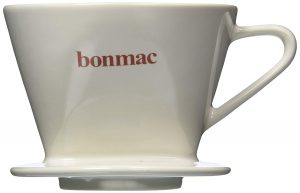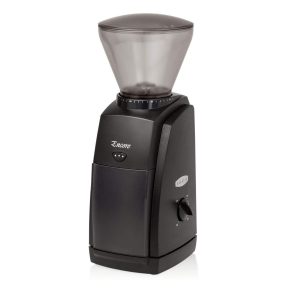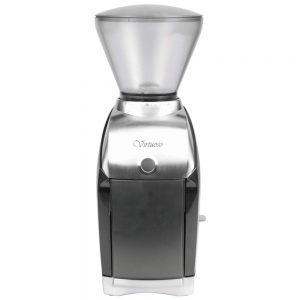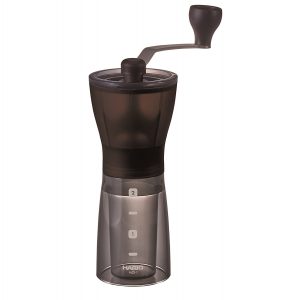What is pour-over?
First things first, we’re going to have to get this out of the way. Pour-over is a method of heating water up to an ideal temperature, preferably till it boils, then pour it in an even stream over a small batch of coffee grounds fitted in a dripper which has a filter. Either way, some of the best gears for making pour-over coffee are drippers, scales, kettles, and grinders.
The dripper is usually shaped like a cone or wedge and controls the rate at which the water filters through the coffee, but that’s just the most fundamental level of coffee preparation.
This preparation method (which consists of basically of using one stream of water rather than a shower of hot water like you’d find in a coffee maker) results in a coffee brew that’s hotter than usual. This happens because there is far less temperature loss from one thick stream as compared to the exposed surface area of individual streams of water. If you know anything about the coffee preparation process, then you’re probably aware of how crucial the water quality and temperature are with regards to the overall reaction rate in your coffee preparation set. As a rule of thumb, hotter, cleaner water means a faster reaction and better coffee. Use fresh, clean water to promote the more extraction from the surface layer of the coffee grounds.
Additionally, unlike some other methods of preparing coffee, the pour-over method leads to continual replenishment of the liquid surrounding the coffee grounds with consistently new and fresh water. This is one of the greatest winning points of this method that leads to the production of a faster, less bitter brew.
Things You Will Need
- A scale – this is for measuring the amount of water and coffee grounds
- A kettle with an extended neck.
- A dripper with a filter.
- A good conical burr grinder.
- A timer.
These items aren’t mandatory but would be nice to have
- A stirrer for agitating the wet grounds.
- A dedicated carafe to brew coffee.
Best Gears for Making Pour-Over Coffee
-
Dripper
The Winner: Kalita Wave 185 Dripper
 The Kalita was able to make it to the top of our list because it’s cheap and has a well-constructed body that will help it last quite a while. At its pricing point, it’s able to extract the best flavors from your coffee grounds. This is in part due to its unique design – it has a signature flat bottom that allows the grounds to extract over a large surface area, giving your coffee more consistent and overall better taste. It also features wavy filters that are made from high-quality paper that doesn’t give the coffee that annoying papery taste and prevents it from losing temperature much better than most other filters. Compared to other paper filters you’re bound to come across in the market, it has the richest taste.
The Kalita was able to make it to the top of our list because it’s cheap and has a well-constructed body that will help it last quite a while. At its pricing point, it’s able to extract the best flavors from your coffee grounds. This is in part due to its unique design – it has a signature flat bottom that allows the grounds to extract over a large surface area, giving your coffee more consistent and overall better taste. It also features wavy filters that are made from high-quality paper that doesn’t give the coffee that annoying papery taste and prevents it from losing temperature much better than most other filters. Compared to other paper filters you’re bound to come across in the market, it has the richest taste.
When it comes to ease-of-use, the Kalita Wave 185 Dripper also comes out on top. It’s pretty easy to use, producing great coffee without having to be watched over obsessively. It also requires far less water pulsing due to its aforementioned design principles – the same flat bottom that contributes to taste also regulates the rate at which the water drains. Normally, cone-bottom drippers only have a single exit point for the water, making the coffee’s taste more dependent on how you pour the water into the grounds. This creates a very discernible difference when it comes to pulsing your brew water through the full cycle and simply pouring your water and letting the rest take its own course.
Disadvantages of the Kalita Wave 185 Dripper
There is one major flaw when it comes to this model, though, and that comes down to its proprietary wavy filters. Since the Kalita is a Japanese-made model, the filters are far harder to come across that you would native-made filters. If you don’t mind the hassle, you can find them on Amazon or specific coffee shops all over the country.
Runner-up: Bee House Ceramic Coffee Dripper
If you’re a beginner at brewing coffee, the Bee House Dripper would make the perfect entry point  for you. When it comes to putting it to practical use, it’s one of the easiest models to use. It’s an affordable model that’s well-rounded in its ability to produce good-tasting coffee while retaining its accessibility to the masses.
for you. When it comes to putting it to practical use, it’s one of the easiest models to use. It’s an affordable model that’s well-rounded in its ability to produce good-tasting coffee while retaining its accessibility to the masses.
Despite being respectably good, it doesn’t score full marks when it comes down to taste. Sure, the coffee is pretty good. A lot better than you’ll find on some more expensive models, but it doesn’t top the Kalita in this one regard. Perhaps the best selling point for the Bee House is the fact that its filters are very easily available.
Second runner-up: Chemex Six Cup Classic Series
 The Chemex Six Cup’s winning point is its award-deserving design and simplicity of use. It produces a great coffee, winning full points in that department, creating perhaps the least mess of all the coffee makers on this list – something we attribute to the fact that it acts as its own pitcher. What really got it on our list of best coffee makers, though, was the fact that it’s the only model here that can easily accommodate making more than one cup of coffee at a go.
The Chemex Six Cup’s winning point is its award-deserving design and simplicity of use. It produces a great coffee, winning full points in that department, creating perhaps the least mess of all the coffee makers on this list – something we attribute to the fact that it acts as its own pitcher. What really got it on our list of best coffee makers, though, was the fact that it’s the only model here that can easily accommodate making more than one cup of coffee at a go.
When preparing your coffee, you don’t want the sweetness to be more pronounced than the flavor of the coffee, and the coffee definitely shouldn’t be bitter. The Chemex excels at balancing the two out quite perfectly. However, depending on your method of preparation, the sweetness may overwhelm the taste a time or two over. It’s difficult to produce a consistent taste across the board every time you prepare your coffee, partly because the Chemex comes with really thick filters. These filters sometimes extract some of the body of the coffee, so overall, this model produces a less sturdy brew than our top pick.
If you’re planning to host this particular model anywhere, it’s perfect to use at home, reason being: it’s been around since forever, giving the manufacturers plenty of time tweaking various aspects of the machine and making it more suited for home use. It’s simple, unobtrusive and makes brewing coffee on a large scale, e.g. for guests much easier than making a single brew at a time. Another point in its favor is the gorgeous design, something you won’t find even in the Kalita, despite its revered position as our first pick.
Disadvantage Chemex Six Cup Classic Series
The main drawback to getting this lovely beauty is that it uses proprietary filters, just like the Kalita Wave, and these are quite a hassle to track down if you don’t live near a specialized coffee shop or a grocery store chain. If you’re willing to get an Amazon Prime membership for this sole purpose, you can get an expedited order. Lastly, the Chemex also requires a fair amount of cleaning; the narrow neck of its pitcher might present a considerable amount of trouble, but if you have a proper bottle brush, you should be able to make it through smoothly.
Best Dripper: The competition
Melitta Pour-Over Coffee Brewer
The Melitta is a single cup coffee brewer that’s both cheap and generally well-liked. In  terms of taste, it’s mediocre at best – it doesn’t present anything new or unique and will be cumbersome to use if you’re a first timer.
terms of taste, it’s mediocre at best – it doesn’t present anything new or unique and will be cumbersome to use if you’re a first timer.
Bonmac Ceramic Dripper
 The Bonmac Dripper is a distant cousin to the Bee House Ceramic Coffee Dripper, with the main difference being that it doesn’t produce coffee quite as smooth. The Bonmac Dripper is perfect for a beginner coffee maker. The beauty of this dripper is that the ridges are designed to help water flow evenly thus crossing out the need for for using a gooseneck kettle.
The Bonmac Dripper is a distant cousin to the Bee House Ceramic Coffee Dripper, with the main difference being that it doesn’t produce coffee quite as smooth. The Bonmac Dripper is perfect for a beginner coffee maker. The beauty of this dripper is that the ridges are designed to help water flow evenly thus crossing out the need for for using a gooseneck kettle.
Hario V60 Dripper
If you’re a coffee fanatic, you’ve probably heard of the Hario. It’s beloved among coffee experts and the standard model in many coffee competitions. It’s easy to see why, since it produces a consistent flavor across different scopes, and the coffee is quite good itself. However, preparing the actual coffee is hard because of its cone shape and will tend to extract too much or too little flavor from coffee grounds.
experts and the standard model in many coffee competitions. It’s easy to see why, since it produces a consistent flavor across different scopes, and the coffee is quite good itself. However, preparing the actual coffee is hard because of its cone shape and will tend to extract too much or too little flavor from coffee grounds.
Able Brewing Kone Coffee Filter
 The Able Brewing Kone was recommended to us as an alternative to paper filters since they are somewhat difficult to work with. It does offer an interesting solution to the unavailability conundrum but features larger holes than a paper filter normally would and thus produces a coffee brew high in sediment and most times too sludgy to be drinkable.
The Able Brewing Kone was recommended to us as an alternative to paper filters since they are somewhat difficult to work with. It does offer an interesting solution to the unavailability conundrum but features larger holes than a paper filter normally would and thus produces a coffee brew high in sediment and most times too sludgy to be drinkable.
If you really want to try pour-over coffee as opposed to more traditional methods, you’re going to need a few more supplies other than the dripper itself.
-
Grinders
Regardless of what coffee preparation guide you follow and what method you use to brew your coffee, you will need a burr grinder if you want the best-tasting coffee. The thing to note about buying a cheap grinder, though, is that if it’s below the reasonably cheap threshold, it’s likely a poor quality model and will lead to a muddled, sludgy coffee. An even worse decision would be to use a blade grinder. These are terribly old and will be so much trouble to use and the resultant coffee so bad, it’s a decision you will likely regret.
The winner: Baratza Encore Conical Burr Coffee Grinder with Bin
The Baratza Encore is our grinder of choice, and hopefully yours because of its affordability  and consistently solid performance. Baratza is very popular for their high-quality coffee grinders and is responsible for some of the most durable products you’ll find.
and consistently solid performance. Baratza is very popular for their high-quality coffee grinders and is responsible for some of the most durable products you’ll find.
The Encore’s base mechanism operates on conical burrs. Meaning it possesses two wheels used in the grinding mechanism, both of which are cone-shaped and are more variable when it comes down to grind-size than their neighbors the flat-shaped burrs. This unique shape gives them a more sensitive grind control making them all the more suitable for producing consistent coffee grounds. However, if you expect to produce finer grinds, for instance, what you’d require to prepare an espresso, the Encore is known to fall short in that regard. For that, the next pick on this list might interest you a little more.
Runner-up: Baratza Virtuoso
 The Baratza Virtuoso comes at the cost of an extra $100 over its rival sibling, but with a catch. It produces far finer coffee grounds, and isn’t a machine an everyday user would even be remotely interested in. If you’re simply planning on making pour-over coffee and not espresso, spare the extra money and get an even nicer machine.
The Baratza Virtuoso comes at the cost of an extra $100 over its rival sibling, but with a catch. It produces far finer coffee grounds, and isn’t a machine an everyday user would even be remotely interested in. If you’re simply planning on making pour-over coffee and not espresso, spare the extra money and get an even nicer machine.
Second runner-up: Hario Mini Mill Slim Hand Coffee Grinder
If the price tag on the Baratza is way above your budget, you might want to consider the  Hario Mini Mill. It comes with a bit of a limited capacity. But this shouldn’t be too big an issue for most users since most recipes for preparing pour-over coffee don’t exceed the device’s approximate 50-gram capacity. Unless you use really big cups, the average American cup takes about 18 to 20 grams of coffee.
Hario Mini Mill. It comes with a bit of a limited capacity. But this shouldn’t be too big an issue for most users since most recipes for preparing pour-over coffee don’t exceed the device’s approximate 50-gram capacity. Unless you use really big cups, the average American cup takes about 18 to 20 grams of coffee.
The Hario features a lot more plastic parts on its body than the full-size Hario and is thus lightweight, but lacks in one crucial feature that leads to less consistent grinds – the spring-loaded grind-adjustment mechanism. Despite this though, it’s a tough cookie, and should last you quite a while. Just don’t drop it.
-
Kettles
When it comes down to kettles, you have most of your work cut out for you. A kettle is a simple device and as such, you don’t have to look out for when buying one: all you need to consider is temperature control and an elongated spout to enable you to control how much water you’re pouring and how fast you pour it. Regarding temperature control, a kettle should be able to bring water to a boil fast enough – about three minutes should be enough time to bring it to a steady boil if you’re willing to wait a minute or two for it to cool down.
The top pick: Bonavita BV3825B 1.0L Electric Gooseneck Kettle
 The Bonavita BV3825B heats water to boiling temperature in about four minutes, from where it’s up to you to wait while the water cools down to a more realistically usable temperature. It’s definitely prettier than most other models and really comfortable to handle. Its base construction is somewhat flimsy. But it does come with an auto-shutoff feature that’s near impossible to come across anywhere else.
The Bonavita BV3825B heats water to boiling temperature in about four minutes, from where it’s up to you to wait while the water cools down to a more realistically usable temperature. It’s definitely prettier than most other models and really comfortable to handle. Its base construction is somewhat flimsy. But it does come with an auto-shutoff feature that’s near impossible to come across anywhere else.
First runner-up: Bonavita BV382510V 1.0L Digital Variable Temperature Gooseneck Kettle
If you’re more detail oriented, in that you like to heat your coffee-brewing water to precise temperatures and worry a lot about the same, then you may be willing to spend just a little more on a more adjustable model than the previous one. This is pretty important to keep in mind. For instance, you’re aware of the origin of your coffee beans and wish to adjust your temperatures accordingly to avoid an outcome of a bitter-tasting brew. When it comes, to temperature control, the BV382510V is literally unbeatable. What makes it so unique? The ‘hold-temperature’ function, that, well, keeps the temperature constant so you can forget the kettle for a while you take care of other duties, till you’re ready to pour.
temperatures and worry a lot about the same, then you may be willing to spend just a little more on a more adjustable model than the previous one. This is pretty important to keep in mind. For instance, you’re aware of the origin of your coffee beans and wish to adjust your temperatures accordingly to avoid an outcome of a bitter-tasting brew. When it comes, to temperature control, the BV382510V is literally unbeatable. What makes it so unique? The ‘hold-temperature’ function, that, well, keeps the temperature constant so you can forget the kettle for a while you take care of other duties, till you’re ready to pour.
Second runner-up: Hario V60 Drip Kettle Buono
 If you prefer to have a stovetop kettle rather than a more intuitive solution, go for the Hario V60 Kettle. Its pourer is not as precise as the Bonavita due to a wider, rounder opening. But is pretty durable, which is the main point the Bonavita fails at (Its spout is prone to breakage when exposed to high temperatures).
If you prefer to have a stovetop kettle rather than a more intuitive solution, go for the Hario V60 Kettle. Its pourer is not as precise as the Bonavita due to a wider, rounder opening. But is pretty durable, which is the main point the Bonavita fails at (Its spout is prone to breakage when exposed to high temperatures).
(This isn’t an issue with the electric versions. Because you have no direct exposure to heating coils or flames to worry about there.)
If you prefer to get an electric version instead, which, by the way, is less prone to breaking since there is no direct exposure to the flames, the Hario Buono comes in a different model to suit you. It does cost a little bit more and doesn’t pour very well, but is quite popular in high-end cafes.
-
Scales
Making a consistently great brew of coffee is all about technique. And at the core of the technique is knowing how much coffee to use, which, in itself, involves using a scale. Some guides would refer you to using volumetric measurements instead. But there are many factors that influence the same that make it an untrustworthy method of getting an accurate measure for your coffee. When it comes down to making coffee. Even a gram too much or too little can make the all the difference between two strong, too light and just right.
The winner: American Weigh Scales SC-2KG Digital Pocket Scale
The American Weigh Scale is our first recommended model because of various factors that  contribute to its greatness. Its cheap does the job perfectly and is easy to move around. Which is a good thing if you want to have a coffee maker while on the move. Another factor is its precision since its accurate up to a tenth of a gram. Which is just perfect if you want the strongest brew of coffee you can possibly make. Lastly, it comes with a backlit screen for easy reading even in low light conditions.
contribute to its greatness. Its cheap does the job perfectly and is easy to move around. Which is a good thing if you want to have a coffee maker while on the move. Another factor is its precision since its accurate up to a tenth of a gram. Which is just perfect if you want the strongest brew of coffee you can possibly make. Lastly, it comes with a backlit screen for easy reading even in low light conditions.
The runner-up: Hario V60 Drip Scale
 If you’re often busy but prefer to brew your coffee on a daily basis, the Hario V60 may be the machine for you. It comes with a timer to help you keep track of your brew time so you don’t go overboard with it. It also has an intuitive user interface that will allow you to start both the timer and scale simultaneously.
If you’re often busy but prefer to brew your coffee on a daily basis, the Hario V60 may be the machine for you. It comes with a timer to help you keep track of your brew time so you don’t go overboard with it. It also has an intuitive user interface that will allow you to start both the timer and scale simultaneously.
This way, you can monitor how much water you pour over your coffee grounds. Together with the rate of flow of your brew. The digital display it comes with also presents the brew time and the weight of you coffee side by side. Which is pretty nice because you don’t have to keep jumping between screens to check either one of the measurements. The last neat feature the Hario has is delayed auto-turnoff, which gives you a little more control over how and when you should tinker the scale and prepare your coffee.

